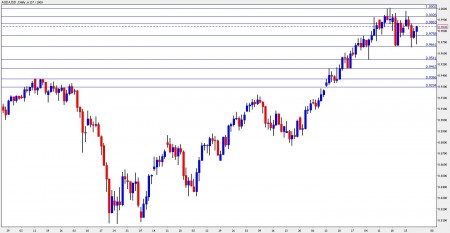A very busy week expects Aussie traders, with the rate decision being the highlight of 12 events. Here’s an outlook for these events, and an updated technical analysis for AUD/USD.
AUD/USD daily chart with support and resistance lines on it. Click to enlarge:
AUD/USD got closer to parity at the beginning of the week, but retreated afterwards. A surprise hike can send it over the top, and so can a big QE program from the US. Let’s start:
- AIG Manufacturing Index: Sunday, 22:30. The Australia Industry Group publishes a monthly PMI-like index for different sectors, and fills in the gap for the government. The manufacturing index disappointed last month and dropped to 47.3, below the critical 50 point line. This means economic contraction. A rise above 50 is expected this time.
- MI Inflation Gauge: Sunday, 23:00. Also here, an independent research institute provides data that the government doesn’t release on a monthly basis. Melbourne Institute’s inflation gauge has shown very steady rises in prices – only 0.1%. A stronger rise is expected this time.
- HPI: Monday, 00:30. While this isn’t the most up to date figure, the quarterly scope makes this figure important. During the past year, the rise in house prices exceeded expectations. After a strong 3.1% in Q2, a small rise of 0.1% is expected this time.
- Chinese Manufacturing PMI: Monday, 1:00. When Australia’s main trade partner releases important figures, the Aussie rocks. Purchasing managers’ index unexpectedly rose to 53.8 points last month. It’s expected to stay at the same level this time. Note that any number above 50 means expansion, which is positive for the Aussie.
- Commodity Prices: Monday, 5:30. The Australian economy relies on exports of commodities, mostly iron ore and coal. Changes in prices always move the Aussie. The year over year rise has been around 50% in the past months. A similar figure is expected now.
- Rate decision: Tuesday, 3:30. There were high expectations for a rate hike last time, but the RBA disappointed and left the Cash Rate unchanged at 4.50%, still much higher than other Western countries. There is no 100% consensus about the upcoming decision. On one hand, the Australian economy is booming, with a strong job market and strong growth. On the other hand, Australian CPI rose less than expected, meaning that there’s no rush to raise the rates. Also the ongoing currency war and the tense wait for the FOMC decision will probably translate into another “wait and see” decision.
- AIG Services Index: Tuesday, 22:30. The second release from AIG refers to the services sector, which is an important sector. The result has been weak in recent months, sitting under 50. Last month’s score was 45.6. It’s now expected to improve.
- Building Approvals: Wednesday, 00:30. This is an important gauge for the whole economy, even though it’s very volatile and tends to flip every month. After a drop of 4.7% last month, it’s now expected to remain unchanged.
- Retail Sales: Thursday, 00:30. Australian consumers have shown caution last month, with a small rise of only 0.3% in the volume of sales. A stronger rise is expected now – 0.5%. This is a rather stable indicator.
- Trade Balance: Thursday, 00:30. Australia enjoys a nice surplus in its trade balance in the past 5 months. After jumping to 2.35 billion last time, a small squeeze is predicted now – to 2.13 billion.
- AIG Construction Index: Thursday, 22:30. The last figure from AIG is expected to show a small improvement in this sector, that dipped last month. The score was 40.8 points.
- RBA Monetary Policy Statement: Friday, 00:30. This quarterly release always rocks the Aussie. The central bank releases a wide overview of the economy, including employment and inflation expectations. Hints for future monetary policy also tend to appear in this report.
* All times are GMT.
AUD/USD Technical Analysis
The AUD/USD began the week with a drop, with recovery attempts stopping at the 0.9863 line mentioned last week. It later continued and dropped to the 0.9660 line, before recovering at 0.9838.
AUD/USD is now between 0.9863, which served as a strong resistance line in the past week, and also supported the pair beforehand, to 0.9750, which capped the pair on the way up, and is now a minor line of support.
Looking down, 0.9660 is a very strong line, as it provided strong support for a second week in a row. Lower, 0.9540 was a swing low earlier this month and is the next minor line of support.
Below, 0.9465 remains an important line on the way down, working both as support and as resistance a few weeks ago. The next lines below are 0.9366, which was a peak back in April, and 0.9327, which worked as fierce resistance several times during the past year. The Aussie jumped above this line on a weekend gap.
Looking up above 0.9863, minor support is found at 0.9926, which worked twice as resistance. More serious support appears only at AUD/USD parity. The last peak before parity was touched was 0.9917, but it isn’t significant anymore.
I turn neutral on AUD/USD.
The weak CPI means that the chances of rate hike are lower. A rate hike in Australia and a huge QE program in the US could send the Aussie beyond parity, but this scenario seems unlikely. What is more likely is very high volatility.
Further reading:
- For a broad view of all the week’s major events worldwide, read the USD outlook.
- For EUR/USD, check out the Euro/Dollar forecast.
- For the Japanese yen, read the USD/JPY forecast.
- For GBP/USD (cable), look into the British Pound forecast.
- For the New Zealand dollar (kiwi), read the NZD forecast.
- For USD/CAD (loonie), check out the Canadian dollar.
Want to see what other traders are doing in real accounts? Check out Currensee. It’s free..

